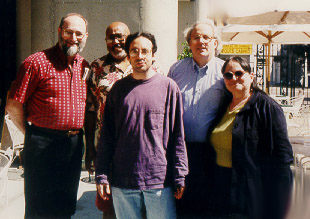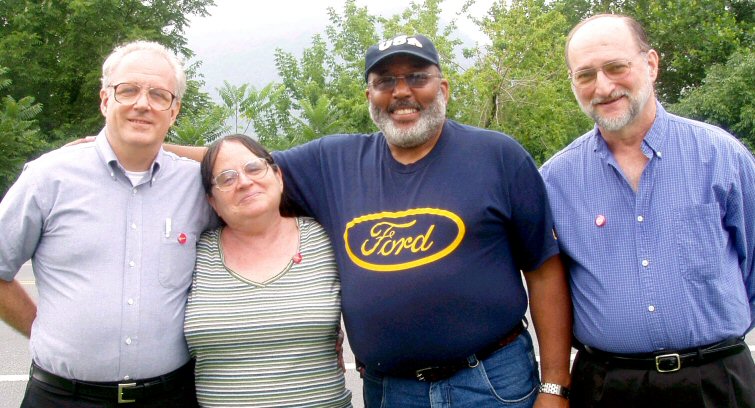ACN
The Amateur Computerist
First appearing on February 11, 1988
The Amateur Computerist is a newsletter covering computers, the internet, netizens and
the world they are imbedded in.
The Amateur Computerist grew out of a battle against the
cancellation in 1986 of computer programming classes for hourly workers
at the Ford Motor Company Rouge Factory near Detroit Michigan USA. The
newsletter originally dealt with computer issues and labor issues. By
2018 there were 62 issues scanning more than 30 years covering computer
and internet history, the development of netizens and netizenship and
examples of netizen journalism reporting on events of international
importance.
The founding meetings of the Amateur Computerist in
1987, Ronda Hauben, Norman O. Thompson, William Rohler, Michael
Hauben, and Steve Alexander discussed what to name the new
newsletter. "Beginning Computerist" was suggested. Michael argued
that the newsletter would be for all lovers of computing not just
beginners. Since an amateur does something for the love of it not
for financial gain, his suggestion of Amateur Computerist was
adopted.
The first issue of the newsletter was published February 11, 1988.
It was dedicated to the Flint sit-down pioneers. Their 44-day strike (Dec
30, 1936 to Feb 11, 1937) gave impetus to the development of the UAW.
Articles appeared in the newsletter from one of those pioneers who
welcomed the newsletter and the computer, saying, "From the Great Wall to
the Great Pyramid, from the hieroglyphics to the screen of the computer,
mankind is still progressing." ("Dawn
of a New Era", Vol 1, No. 1) The
sit-downer pioneers who built the UAW believed that the problems of
automation had still to be solved by the upcoming generation.
The newsletter is dedicated to support for grassroots efforts
and movements like the "computers for the people movement" that gave
birth to the personal computer in the 1970's and 1980's. Work of many
people over hundreds of years led to the production of a working
computer in the 1940's and then a personal computer that people could
afford beginning in the 1970's. This history was serialized in several issues of
the newsletter.
The Amateur Computerist was described by Andrew Ross and
Constance Pawley in their book "Technoculture" (Univ of Minnesota
Press, 1991, p. 125) as follows:
"When worker education classes in computer programming were discontinued
by management at the Ford Rouge Plant in Dearborn, Michigan, United Auto
Workers members began to publish a newsletter called the 'Amateur
Computerist' to fill the gap. Among the columnists and correspondents in
the magazine have been veterans of the Flint sit-down strikes who see a
clear historical continuity between the problem of labor organization in
the thirties and the problem of automation and deskilling today. Workers'
computer literacy is seen as essential not only to the demystification of
the computer and the reskilling of workers, but also to labor's capacity
to intervene in decisions about new technologies that might result in
shorter hours and thus in `work efficiency' rather than worker
efficiency."
In 1993 Henry Hardy wrote: "Interestingly, it seems that most
of the material treating the Net from the historical perspective has
come from those on the Net itself. Much interesting material has been
generated on Usenet and BITNET .. In addition, there are an increasing
number of electronic journals which have made important contributions,
such as the Amateur Computerist, the Electronic Journal of Virtual
Culture and Computer Underground Digest." History
of the Net
Articles in the Amateur Computerist chronicled the development
and spread of computers and then the Internet. The history of UNIX, the
ARPANET, TCP/IP and the role of JCR Licklider were highlighted. The
work of Michael Hauben often appeared in the newsletter.
Since its beginning, William Rohler, Norman O. Thompson and Ronda
Hauben have been its founding and sustaining editors. Michael Hauben was
also a founding editor and gave the newsletter its name. He made
substantial contributions during its first 13 years. Jay Hauben joined the
editorial team in the 90s.
Issue Format:
- Early issues were in ASCII text
All issues are now PDF in one and two column versions (see http://www.ais.org/~jrh/acn/NewIndex.pdf)
- The one column version is easier to read on mobile devices
Access
http://www.ais.org/~jrh/acn/
http://www.cc.columbia.edu/~hauben/acn/
Contact
- Editors:
- Ronda Hauben <ronda.netizen@gmail.com>
William Rohler
<wrohler@comcast.net>
Norman O. Thompson <not5097@yahoo.com>
Jay
Hauben <hauben@columbia.edu>
Send us a message.
 The ACN Staff in 1998
The ACN Staff in 1998
William Rohler, Norman O. Thompson, Jay Hauben, Ronda
Hauben
Michael Hauben (1973-2001)
 The ACN Staff in 2003
The ACN Staff in 2003
Return to the ACN Homepage

